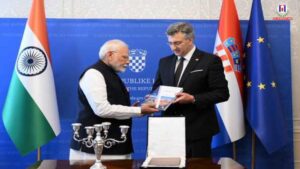
By Siddharth Pandey
The Israel-Palestine has been an introduction for many to understanding international tensions and hostilities, especially because it is centred in the US discourse. As a result, there have been attempts to draw parallels with the India-Pakistan conflict. This comparison, while natural, is a terrible oversimplification of the complexities of the situation. Proponents of the idea went as far as to point out that India’s use of the Israeli Harop drones somehow proved the similarities.
Both India and Pakistan are sovereign states, with minimal weight in the internal matters of the other country. They enjoy unique geopolitical positions. Pakistan maintains close ties with the US and China. India has recently strengthened its ties with the US, while also preserving its longstanding relations with Russia. Neither nations are directly antagonistic to the US.
However, while China and Russia are the biggest weapon suppliers of Pakistan and India respectively, it is the US that has played the most significant role in the India-Pakistan relations.
While ceasefire has been announced as of May 10, the fragility of peace is evident due to the abeyance of the 1960 Indus Water Treaty. The suspension of the treaty will invariably lead to further tensions. It is crucial, then, to contextualise the long-standing conflict between the two nations, and why India’s evolution in its approach to cross-border terrorism – marked by Operation Sindoor – has become necessary.
Terrorism and Pakistan: A Long-Standing Legacy[1]
Pakistan has a long history with militancy. Today, several militant groups operate in the country, each with their own areas of operation and objectives. Many focus on Kashmir, others on Afghanistan, while still others have the objective of overthrowing of the Pakistani government. Since the Taliban seized power in Afghanistan, Pakistan has seen a 73% rise in terror attacks. This includes Tehreek-e-Taliban (TTP) or Pakistani Taliban, and the Baluchistan Liberation Army (BLA). The TTP enjoys support from Afghanistan, and the Pakistani airstrikes in 2022 were said to be in retaliation to the surge in such militancy.
The increase in terrorism in Pakistan has been a product of its own making. Since the War on Terror began in 2001, Pakistan aligned itself with the US, but has displayed a selective approach in its dealing with terrorist organisations. Groups such as Hizb-ul-Mujahideen (HM), Lashkar-e-Taiba (LeT), Harkat-ul-Mujahideen (HuM), and Jaish-e-Mohammad (JeM) received support from the Pakistani military to continue their hostilities against India.
Hizb-ul-Mujahideen, headquartered in Muzaffarabad – where India targeted a LeT training camp – is a terrorist organisation as designated by the US, EU, and India. It has seen a decline, especially after the Indian security forces killed one of their prominent ‘district commander’, Burhan Wani. Often, HM is seen as an auxiliary force that assists the workings of JeM and LeT.
Despite being outlawed in 2002, Jaish-e-Mohammad (JeM) continues to openly operate as JeM, along with its splinter groups including Khuddam Ul-Islam headed by Azhar and Jamaat ul-Furgan led by Abdul Jabbar, underlining Pakistan’s inadequate efforts in dismantling such groups.
JeM is a U.S designated Foreign Terrorist Organization, founded by Masood Azhar, headquartered in Bahawalpur – targeted by India during Operation Sindoor – was responsible for the attack on the Kahsmir Legislative Assembly in 2001. JeM, along with Lashkar-e-Taiba (LeT) was behind the attack on the Indian Parliament, also in 2001.
LeT, also listed as a Foreign Terrorist Organization by the US, is headquartered in Muridke near Lahore – also destroyed during Operation Sindoor. The group led the deadly attacks in Mumbai on 26/11. Although its members were implicated in the attacks, none were prosecuted by the Pakistani government. Instead, its founding members, along with its leader, Hafiz Saeed, can often be seen alongside the Pakistani military officials and continuing his public appearances at rallies.
Pakistan’s Double-Edged Alliance with the US[2]
The War on Terror after 9/11 saw Pakistan once again become a critical ally in the US’s geopolitical interests. The US sought to isolate Afghanistan by breaking the Pakistan-Taliban alliance. The US extended significant economic and military support to Pakistan. The National Security Strategic document had President Bush emphasising that the United States was committed to using economic liberalisation as a tool toward combat terrorism. This support included the lifting of sanctions imposed on Pakistan for its nuclear arsenal. But the greatest reward that the US bestowed upon Pakistan was its legitimising of the military rule in Pakistan, and shielding the state from the valid charges levied by India in the international community.
But Pakistan has repeatedly proven to be a partner with conflicting priorities and questionable credibility. The War on Terror was used by the Pakistani government to target Deobandi and Shia militant groups like Sipah-e-Sahaba (SSP), who aimed to establish a Sunni state in Pakistan and counter the Shia influence. But despite its anti-government activities, due to the importance of its madrassas in providing training and support to the Mujahideen in Kashmir, the government displayed an unwillingness to sustain its efforts to put an end to SSP.
This lack of decisiveness and constantly courting SSP led to the bombing of a Shiite mosque in Karachi in 2003, and the bombing of two other Shiite mosques in 2004, along with attacks on Christian and Western targets and an attempted assassination on Nawaz Sharif. Lashkar-e-Jhangvi took responsibility of each, the group which sought to further the ambition of the SSP.
The US State Department’s 2001 report on identified Pakistan as a key sponsor of militant groups fighting in Jammu and Kashmir. ISI’s has also been involved in supplying arms to insurgents in North-East India, supporting pro-Khalistan terrorist groups in Punjab and actively printing and supplying counterfeit Indian currency notes.
A 2012 NATO study based on 27,000 interrogations of 4,000 captured Taliban and Al Qaeda fighters reported that the ISI provided safe havens to the Taliban, monitored their movements, manipulated their fighters, and arrested those deemed uncooperative.
As a result of its inconsistent policies, political instability, military’s influence on the government, and its continued support to terrorism, US financial aid to Pakistan has been steadily dwindling. From over one billion US dollars in 2010, by 2024, foreign assistance accounted for just over a hundred million US dollars.
But it is not just ISI or the military that has steadily eroded Pakistan’s credibility[3]. In 2020, former Prime Minister Imran Khan while addressing the country’s parliament, referred to Osama Bin Laden as a martyr. A comment that reflected the influence of terror organisations in Pakistan’s politics and with its military establishment.
Subsequently, a year later, the then I&B minister, Chaudhry Fawad Hussain, came to Imran Khan’s defence, touting this ‘gaffe’ as a slip of the tongue, and reiterated that Pakistan considers Osama bin Laden a terrorist.
On the other hand, when minister Fawad Choudhary was the minister of Science & Technology in 2020, he praised Pakistan’s success in hitting India in their home – referring to the 2019 Pulwama attack. No minister has referred to that as a slip of tongue.
Moreover, the recent statements by Pakistani officials, including Asmin Munir and LeT commander Saifullah Muse, reveal the continued use of Kashmir as a tool to stoke tensions with India and therefore, gain credibility for the terrorist organisation or the military.
What a ceasefire means for both countries[4]
Ultimately, Pakistan is a politically unstable country that is facing a severe economic crisis, compounded by domestic militancy in Baluchistan and Khyber-Pakhtunkhwa. It cannot afford a prolonged conflict with India. On the other hand, India’s ambitions are not suited to a war with Pakistan either. Despite being dogged by its own economic downturn, it harbours the ambition of being a global power. Although the success of Operation Sindoor has established India’s willingness to hold Pakistan accountable and enforce a cost to exporting terrorism to India, it has been let down by other institutions of the country. The reinstatement of the Kashmir dispute in the international agenda – OIC, the US, and others – will be a terrible blow to the Indian foreign policy.
On the other hand, the valley-wide outrage over the attacks does indicate a changing domestic dynamic. For the first time in the 35 years of violence and terrorism in the Valley, a shutdown and widespread protests throughout the region condemning the terrorism, a shift in India’s favour, albeit continuous development will be seen as the bridge to further and prosperous assimilation.
Although the economic growth rate of the state at 7.8 percent sits above the 7.77 percent national average, and through a combination of government employment programs like Prime Minister’s Employment Generation Programme (PMEGP), Rural Employment Generation Programme (REGP), and MGNREGA, and a tourism boom has led to a decline in unemployment rate, the state still sits in the among the top three states with the highest unemployment rate.
The Indian government has also been a victim of its own posturing. The constant talk of retaking Pakistan occupied Kashmir, or the ‘ease with which we can deal with Pakistan’ had emboldened its core voters for a far more profound result. The behaviour of TV media during the conflict also worked to hurt India’s credibility. While disinformation is a tactic used during tensions and war, easily disproven claims only work to weaken the credibility of the operation. Other gaffes included the media personality Major Gaurav Arya causing a diplomatic ordeal by abusing the Foreign Minister of Iran.
The act of targeting tourists in Pahalgam by inquiring about their names and religion also suggests a new way to foster divisions within India. Consequently, local and state level instances of communalism must also be seen in the broader context of national security.
[1] Pakistan Army and Terrorism; an unholy alliance, European Foundation for South Asian Studies: 3-6 https://www.efsas.org/Pakistan Army and Terrorism – an unholy alliance.pdf
[2] “Pakistan Army and Terrorism; an unholy alliance”, European Foundation for South Asian Studies: 11-16 https://www.efsas.org/Pakistan Army and Terrorism – an unholy alliance.pdf
[3] Dr. Farzana Shaikh; “Rising tensions resurface Pakistan’s credibility problem– and India’s backfiring policy on Kashmir”, Chatham House, https://www.chathamhouse.org/2025/05/rising-tensions-resurface-pakistans-credibility-problem-and-indias-backfiring-policy
[4] Ayjaz Wani; “Unmasking Pakistan Army’s Growing Frustration with Kashmir”, Observer Research Foundation, https://www.orfonline.org/expert-speak/unmasking-pakistan-army-s-growing-frustration-with-kashmir








No Comments: